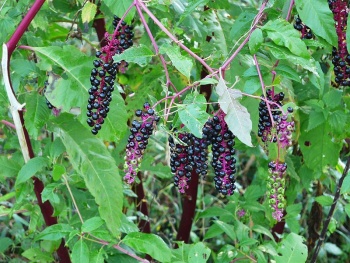Pokeweed
Other names : Phytolacca Americana, Inkberry, Pocan, Pokeweed, Pokeroot, Grubroot, Phytolacca Decandra, American nightshade, Bear’s grape, Cancer root, Jalap, Skoke, Crowberry.
Poke root is an American perennial shrub which grows in damp woodlands, hedges, and waste places. Though the plant may grow up to 3 meters in height, the most unusual physical feature is the large root with its irregular branches. The stems are erect, round, and hairless. They branch near the top and often have a reddish tinge. The short stemmed, light green leaves are 12-20 cm long, a pointed egg shape or oval, their margins entire and wavy. The leafless, flowering stems bears an extended spike of small, greenish-white flowers. The deep purple or black berries ripen in autumn. About 1 cm. in diameter, they contain a purple juice that makes a powerful dye. Unripe berries are slightly poisonous.
Special Precautions of Pokeweed
- Only homeopathic use !
- Do not take homeopathic remedies without first consulting a homeopathic practitioner. Do not take several remedies at the same time as that is often discouraged in homeopathic treatment. Take the recommended dose only and immediately report any changes in condition to your doctor.
- Although poke root, also called pokeweed, has several purported health applications, the substance is known as a highly toxic poison. Poisoning may occur whether you ingest it or use it on your skin. Some herbalists claim that poke root can help tonsillitis, infections, rheumatoid arthritis and even cancer. It also has been used to induce vomiting and to treat infections from fungi. However, many medical institutions recommend against using poke root for any reason. The University of Maryland specifically states that you should never ingest the roots of the plant and that any use of the plant is not safe.
- Low Blood Pressure : Hypotension or low blood pressure may occur in your body if you ingest poke root. Low blood pressure means not enough blood and the oxygen it contains can reach all parts of your body. You may suddenly feel lightheaded or dizzy, and you may faint. Hypotension may prevent you from being able to concentrate normally, and it may send you into a state of depression. You may become very thirsty and your breathing may become shallow and fast. Your vision may blur and you skin may turn pale and cold. If hypotension results because of your ingestion of poke root, you will need medical attention.
- Gastric Problems : Vomiting occurs as an intended effect of taking poke root, but the toxicity of the substance may cause it to continue. You may continue to vomit even beyond the point at which you have nothing left in your stomach to expel. Severe and prolonged vomiting can cause dehydration and bodily weakness. You may feel nauseous before you vomit, and you may experience diarrhea as yet another side effect of ingesting poke root. Seek immediate medical attention.
- Seizures : The toxicity of poke root may disrupt the normal electrical activity in your brain, essentially short-circuiting it and sending you into seizures. Typically, seizures resulting from poke root use take the form of convulsions. You may or may not lose consciousness, but your body will twist and jerk without you being able to control it. You will need an ambulance or a friend or family member to get you to the emergency room of the local hospital for treatment.
- Death : The ingredients in poke root appear so toxic that if you ingest it or use it topically, you may die. Pokeweed causes severe problems in your body as the toxins enter your systems and organs. Again, for this reason, medical experts recommend against any use of poke root.
The benefits of Pokeweed are
Poke root can be used to help stimulate the metabolism which is great for anyone trying to lose weight. It can also be beneficial as a detoxification agent. It is sometimes used in chronic rheumatism and regular conjunctivitis. Other benefits include using as an ointment for psoriasis, sycosis, favus and similar skin conditions. It is particularly used for treatment of the lymphatic system and as an overall cleansing program. In the past it has even been used for certain types of cancer and is well-known for helping to boost the immune system. Poke root can also produce narcotic properties.
- Increasing metabolism
- Sycosis
- Psoriasis
- Cleansing agent
- Boost immune system
- Purgative
- Breast Cancer : Phytolacca decandra (Poke Root); Carcinosinum ; Conium Maculatum and Thuja Occidentalis which, along with others, have a long history of use in breast cancer by homeopaths.
- Ingredient of Hoxsey
- Source of Oleanolic Acid
Phytolacca Profile Type
As with most minor remedies there are scant emotional and physical properties associated. The remedy is mostly used for ailments of the throat and women's breasts. Emotional symptoms when ill are irritability, lethargy and tearfulness. Physical symptoms are a draining fatigue that saps the energy and inhibits clear thought. Pain characteristically comes and goes abruptly. There may also be halitosis. In breastfeeding women pains are worst during feeding and are sharp and stabbing but not steady.
